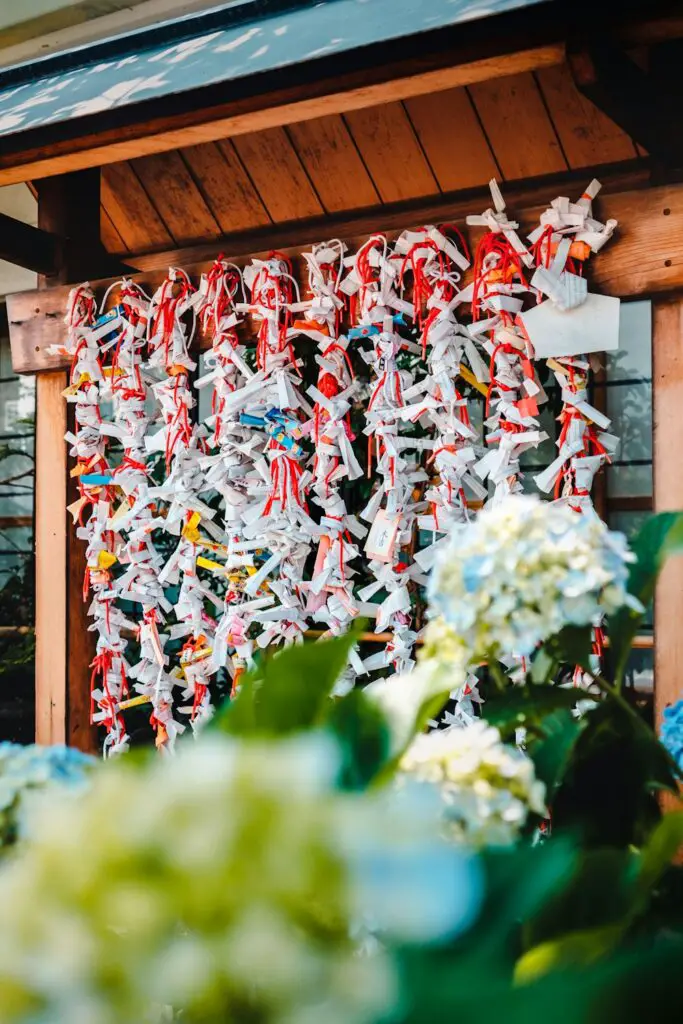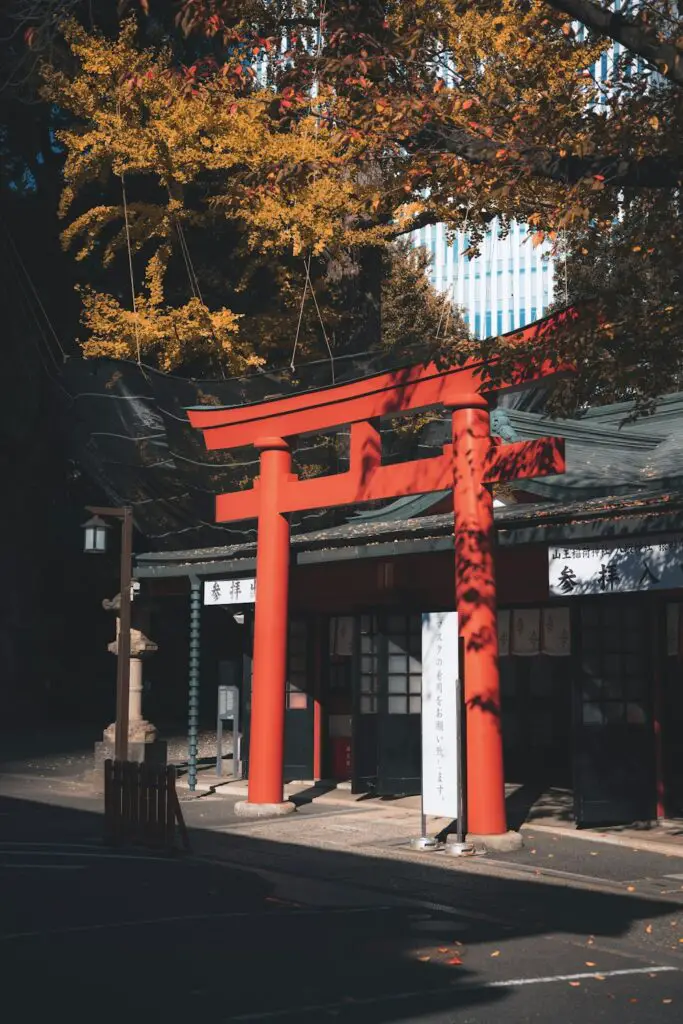Omikuji is a traditional Japanese practice that involves receiving fortune slips in Shinto shrines. These slips are believed to provide guidance and insight into one’s future.
If you’re curious about Omikuji, this article will give you all the information you need.
Key Takeaways
- Omikuji is a traditional Japanese practice that involves receiving fortune slips from shrines and temples. These slips provide insights into one’s future and can be found at religious sites all over Japan.
- To obtain an omikuji, individuals usually make a small donation and then draw a slip from a box or container. The slip will have a number or symbol on it corresponding to a particular fortune.
- Fortunes can range from very good to very bad, or they can be neutral. Some slips even provide specific advice or predictions about different aspects of life, such as love, health, or career.
- Popular shrines and temples to visit for Omikuji include the Meiji Shrine in Tokyo and the Kinkaku-ji in Kyoto.
- Omikuji is a cherished cultural tradition in Japan that many believe can bring positive changes to their lives.

Photo by Kentaro Toma on Unsplash
What Is Omikuji?
Omikuji (御御籤/御神籤/おみくじ) is a traditional form of fortune-telling that you can find in shrines and temples in Japan. It comes in the form of a paper slip that provides insight into your future and offers guidance on how to improve your life.
Unlike other fortune-telling methods, Omikuji goes beyond predicting good or bad luck. It gives detailed information about different aspects of your life, like your finances, health, and relationships.
When you receive an omikuji, you’ll find a written fortune that describes your current situation and provides advice for the future.
Following the guidance on the Omikuji, it’s believed that you can improve your luck and bring positive changes to your life. This unique form of divination is deeply rooted in Japanese culture.
History of Omikuji
Omikuji originated in China and made its way to Japan during the Heian period. Initially known as “Kannon-mikuji,” it had strong connections with Buddhism. Over time, Omikuji gained popularity in Shinto as well.
During the Edo period, Kannon-mikuji became the most popular type of Omikuji. However, with the separation of Buddhism and Shinto during the Meiji Restoration in the 19th century, the use of Kannon-mikuji was no longer possible.
Consequently, Omikuji were now written in waka, a form of Japanese poetry, instead of Chinese poetry.
Today, Omikuji continues to be an integral part of Japanese tradition. People still visit temples to draw an omikuji and discover their fortune. It has become a cherished ritual for many, as they believe it provides insight into their lives and helps them make important decisions.

Photo by Boudewijn Huysmans on Unsplash
How to Draw an Omikuji Fortune Slip?
People visit shrines and temples to receive an omikuji. Getting your omikuji fortune slip is more popular during New Year celebrations or when facing important decisions in life.
In a shrine, the process of drawing Omikuji is quite simple.
- You’ll need to pay a small fee, usually around 100 to 300 yen, as a donation to the shrine or temple you’re visiting.
- Shake a container filled with numbered sticks.
- One stick will come out, and the number on it corresponds to a drawer filled with fortune slips.
- You’ll pick one slip and read your Omikuji.
Some people keep their Omikuji as a good luck charm or a reminder of their aspirations. Others tie them to a designated spot in the shrine or temple, symbolizing their hopes and wishes.
How to Read Your Omikuji?
When it comes to reading your omikuji result and understanding its meaning, there are a few things to keep in mind.
First, look for specific words written in kanji, the Chinese characters used in Japanese writing. These words indicate your overall luck.
Here’s a handy table for understanding your omikuji slip:
| Kanji | Meaning |
|---|---|
| 大吉 (daikichi) | Great luck |
| 中吉 (chūkichi) | Moderate luck |
| 小吉 (shōkichi) | Small luck |
| 吉 (kichi) | Good luck |
| 末吉 (sue kichi) | Future good luck |
| 凶 (kyo) | Bad luck |
| 末凶 (sue-kyo) | Future bad luck |
| 小凶 (sho-kyo) | Small bad luck |
| 大凶 (daikyou) | Great bad luck |
Once you’ve identified your overall luck, you can dive deeper into the detailed information about your fortune in different areas such as love, health, and finances.
Where to Draw Omikuji?

Photo by Willian Justen de Vasconcellos on Unsplash
If you want to get an omikuji, you can visit shrines and temples in Japan. These places have a lot of spiritual significance and are where people go to find guidance and fortune-telling through Omikuji.
Some shrines also have vending machines or gachapon-style machines that let you draw an omikuji fortune slip.
Here are some of the shrines you can visit to get your very own omikuji slip:
Meiji Shrine, Tokyo
Located in Tokyo, Japan, Meiji Shrine is one of the most popular shrines in the city. It offers omikuji slips, which are known as “ō-mikuji”.
Kinkaku-ji (Golden Pavilion), Kyoto
Situated in Kyoto prefecture, Kinkaku-ji is a Zen Buddhist temple that attracts many visitors.
Senso-ji, Tokyo
Located in Tokyo, Senso-ji is an ancient Buddhist temple and the oldest temple in the city. It offers omikuji slips to visitors.
Fushimi Inari Taisha
Situated in Kyoto, Fushimi Inari Taisha is a Shinto shrine dedicated to Inari, the god of rice and agriculture.
Tōdai-ji, Nara
Located in Nara, Japan, Tōdai-ji is a Buddhist temple complex and home to the largest bronze statue of Buddha in Japan.
Itsukushima Shrine, Hiroshima
Situated on the island of Miyajima in Hiroshima, Itsukushima Shrine is known for its iconic floating torii gate.
Yasukuni Shrine
Located in Tokyo, Yasukuni Shrine is a Shinto shrine dedicated to the souls of Japan’s war dead.
Nikko Toshogu Shrine, Nikko
Situated in Nikko, Japan, Nikko Toshogu Shrine is a UNESCO World Heritage Site and a mausoleum of Tokugawa Ieyasu, the founder of the Tokugawa shogunate.
Inariyama Inari Shrine
Located in Omiya, Saitama, Japan, Inariyama Inari Shrine is dedicated to Inari, the god of fertility, agriculture, and foxes.
Hie Jinja, Tokyo
Situated in Tokyo, Hie Jinja is a Shinto shrine known for its vibrant festivals and unique architecture.
Conclusion
Omikuji is a traditional Japanese practice that involves getting fortune slips from shrines and temples. These slips give people insights into their future and can be found at religious sites all over Japan.
With its long history and deep cultural significance, Omikuji remains a popular and cherished tradition in Japan.
People of all ages eagerly unfold their Omikuji, hoping for a positive fortune that will guide them on their journey through life.
If you ever find yourself in Japan, don’t miss the opportunity to try it out and see what the future holds for you!









